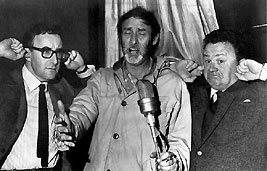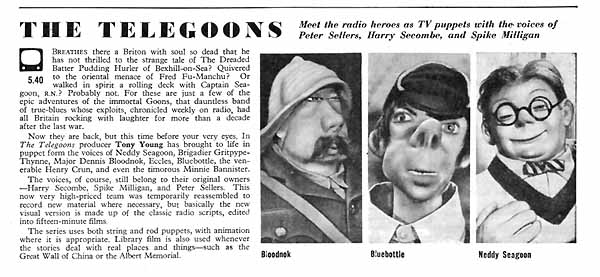|
||||||
| Contents of this Chapter: | ||||||
| Introduction... Radio's Crazy Gang--"The Goons" (...includes a list of the BBC Goon CDs) Goon Shows Preserved While You Wait... The Wonder of Ultra-Kendall-Vision... Running Jumping & Standing Still... Let's See Them Do That On Television! Telegoon Toon Time... Go Ask Eccles & Bluebottle... The Persistence of Goon Memory... Neddie Seagoon Puppet Restoration Fund... |
||||||
|
|
||||||
Voice Actors, Puppeteers & Producers... |
||||||
| Commenting on the magnitude of The
Telegoons production task, producer Tony Young said (Daily Mail,
March 30, 1963), that it was
?A tough job because everyone has his own idea of
what the Goons look like. The production costs of the show will be about ?250,000. Peter, Harry and Spike are getting the highest fees the
B.B.C. has ever paid for 15-minute shows.? Tony further
commented,
?It took three years of planning to get these chaps together. They
don?t work
for peanuts, you know.?
Tony Young was no stranger to Secombe, Sellers, and Milligan, having previously directed them in the1951 comedy film Penny Points to Paradise (see F.A.Q.s). Now twelve years later, Tony was directing them again, although this time performing a script in a sound recording studio. These recordings were edited into the soundtrack of The Telegoons, which was filmed from January to July of 1963, in rented studio space, upstairs in the On-the-Spot Lighting building in Kensal Road, London, W10, overlooking the Grand Union Canal. Although the above account of The Telegoons production covers the standard history, it is far from the whole story. A little known fact is that, for a while, it looked like The Telegoons project was going to be completed sans Sellers, and then only the first filming series of thirteen episodes. Due to the tight scheduling that exists around any such filming venture, and due to Peter Sellers not being immediately available, the voice recording sessions started with just Harry Secombe and Spike Milligan, assisted by an impressionist who stood in for Peter... (see the Film Production section for more details). Peter?s arrival at The Telegoons voice recording sessions at the beginning of March 1963 marked an important milestone in The Telegoons production. Just the week before (during episode 8) the Grosvenor Films production crew had been told that filming could stop after the 1st series (episodes 1 - 13) if Peter could not be obtained. It was actually Harry Secombe who spoke to Peter and persuaded him to join the voice sessions. It is very likely that this occurred right after the announcement to the Grosvenor Films crew, since the first episode that Peter recorded with Harry and Spike was the 9th, The Siege of Fort Knight, which was filmed the next week. After the voices for the subsequent episodes were recorded, Peter to his credit went back and recorded has parts for the first eight episodes. The reassembly of the Goon triumvirate at The Telegoons voice recording sessions in March 1963 was not allowed to go unnoticed, since it marked the first time the Goons had worked together since the radio version of The Goon Show ended in January 1960. The presence of newspaper reporters and photographers, as well as the Telegoon puppets themselves, probably also helped Peter feel welcomed and appreciated. The occasion was given wide publicity in the press (see picture above, and more pictures here). Watching the recording session through a glass panel in the recording booth, producer Tony Young was reported as saying, ?We?ve picked the best episodes from about 500 of the old Goon scripts. All the well-known characters will be there--Neddie Seagoon, Bluebottle, Bloodnok, Eccles, Grytpype-Thynne, Moriarty, Henry Crun, Minnie Bannister....? The same newspaper article captures for posterity a small part of the session, and this is presented below, edited for tense, and somewhat rearranged to conform to the actual script. Due to the presence of the press, and to properly celebrate the Goon reunion, this session was probably more wild than usual...one can always hope! By-the-way, the episode being recorded was Scradge (T.G. 2nd series, #1). A photograph taken during this recording session is shown above (source: Norma Farnes, ibid., p.62). |
|
|||||

